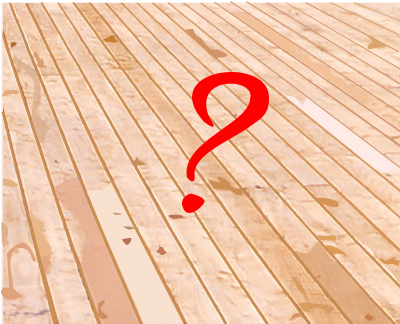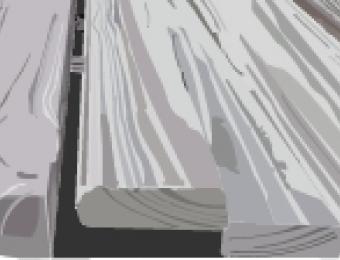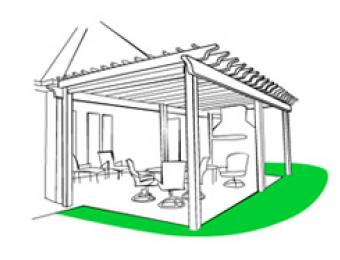
Different timbers are suitable for different circumstances and purposes.
The choice between different types of timbers for decking and pergolas can be a bewildering one, simply because there are so many different options. Aesthetics will inevitably play a big part in your decision - if you're after a particular colour or textured effect, then you've probably already narrowed down your options quite a bit.
You can't base your choice of timber on looks alone though. There are big practical differences between different sorts of timber that can have serious consequences for your decking or pergola, and which make certain types or qualities of timber much more suitable than others for different purposes.
Below are a few of the things you may need to consider:
Softwood or hardwood?
In scientific terms, softwoods and hardwoods derive their name from whether the trees cover their seeds (as is the case for Jarrah, Spotted Gum, Mahogany, Merbau etc.), or just leave them to fall on the ground uncovered (e.g. pine, cypress). In purely technical terms, balsa, one of the softest woods is actually a hardwood, although it's one of the few exceptions to the rule. Hardwoods generally come from deciduous trees and softwoods from evergreens.
In practical terms hardwoods grow more slowly and are more dense. Because of this they're generally harder and tougher than softwoods, and are more expensive. They're also harder to cut, but will normally be very long wearing and more resistant to weathering with less maintenance than softwoods. There are about 100 times more species of hardwoods in existence than there are softwoods, but because softwoods are easier to season and work with, they're more commonly used in construction than hardwoods are.
Seasoned or new timber?
The age of the timber and whether or not it has been seasoned will play a major part in the longevity of the wood chosen. Unseasoned or ‘green’ wood will contain a great deal of the timber's original moisture content. As this leaves the wood over time it will experience shrinkage and warp and twist the timber, buckling your deck.
It is extremely important that the wood you use is not only seasoned, but seasoned correctly. Seasoning is typically done in a kiln with sawn timber. Wood that gets dried too quickly will shrink on the surface and compress the moisture rich wood underneath, which can make the wood highly unstable when the pressure is released. Timber will also naturally lose its moisture and become seasoned if it's left out to air dry, making older timber preferable if it's an option.
Hardwoods and softwoods both have roughly the same moisture content as a percentage, but because hardwoods are more dense, seasoning them is nowhere near as simple a task. The added effort involved in properly seasoning hardwoods also adds to their expense.
H level treatments
The H stands for 'Hazard' and in this case, applies to hazards affecting the expected lifetime of the wood. These include things like susceptibility to fungal growth and insects like termites. H level treatments are chemical compounds introduced to the wood to preserve it, and are assigned numbers such as H1, H2 H3 and so forth, with each level designed for a particular use (see table below).
It is even possible to introduce fire retardant chemicals so the deck is better able to resist flames. Treated timber is usually
sapwood rather than
heartwood which cannot effectively be treated. Heartwood contains a lot of natural saps and resins which prevent the uptake of the chemicals so any treatment is unlikely to penetrate sufficiently into the wood to be of use.
| Treatment level |
Purpose and suitability |
Protected against |
|---|
| H1 |
Indoors, above ground (e.g. furniture, moldings, indoor flooring) |
Insects other than termites |
| H2 |
Indoors, above ground (e.g. framing, flooring) |
Termites and borers |
| H3 |
Outdoors, above ground (e.g. decking boards, fascia, window joinery, framing) |
Moderate decay, borers and termites |
| H4 |
Outdoors, in contact with ground (e.g. pergolas, fencing) |
Severe decay, borers and termites |
| H5 |
Outdoors, in contact with ground or fresh water (footings, house stumps, retaining walls) |
Very severe decay, borers and termites |
| H6 |
Marine water (e.g. jetties and piers, marine piles) |
Marine wood borers and decay |
Natural durability ratings
Timber is assigned what's known as a natural durability rating based on the timber's natural resistance to things like funghi and insects (borers, termites etc.). This rating applies to the
heartwood of the timber, because for all species, the
sapwood has a poor level of durability - remember, treatments can be applied to protect the sapwood but not the heartwood.
Different species are classified into one of four classes, with Class 1 being the most durable and Class 4 being the least durable. Footings and posts (or anything else in contact with the ground) should be durability class 1 or 2 timber, with sapwood removed or treated to H5. Timber decking, handrails and pergolas are typically made from durability class 1 or 2 timbers, with sapwood either removed or preservative treated to H3, or softwoods preservative treated to H3. In some cases durability class 3 and 4 timbers may be usable for these purposes though.
F and MGP ratings
F and MGP ratings give you an idea of each wood’s relative strength under stress; ratings are ascending, F1, F2, F3 and so on - the higher the rating the stronger the wood. Bearers and joists for decking and pergolas should be at least F7, while posts should be at least F11 if they're hardwood, and F7 or better if they're a softwood.
MGP ratings apply only to Machine Graded Pine which may not be what you’re laying on your deck, but may be what you choose to use for the bearers and joists. Three MGP ratings are currently available: MGP 10, MGP 12 and MGP 15. In terms of F ratings these ratings correspond to F5, F8 and F11, respectively.
Environmental considerations
Your choice of wood should also factor in where you are on the map. If you’re in a bushfire prone area for example, you will want a wood which meets all the local codes for fire safety.
It's worth considering the environmental impacts of the timber you're choosing as well. To begin with, wood sourced from overseas, even if it's cheaper to buy, has to be shipped here which incurs an environmental cost in terms of the fuel that's burned in transport.
Likewise, some timbers are heavily (and often illegally) logged from very sensitive parts of the world. Merbau in particular presents quite a problem. The logging of merbau often harms the forest around it, and although new laws in Australia prevent the sale of illegally logged timber, it's rarely clear exactly where it's come from or how it's been logged. In many parts of the world merbau is no longer used because of its serious environmental impact.
Choosing locally sourced wood, or wood from certified sustainable sources in general will ensure that you're not causing more damage than you might realise.
Another environmentally friendly option is to use recycled or reclaimed timber. This timber has the added benefit of already being nicely seasoned too.
Find out more about how to tell if what you're buying is from sustainable sources.




